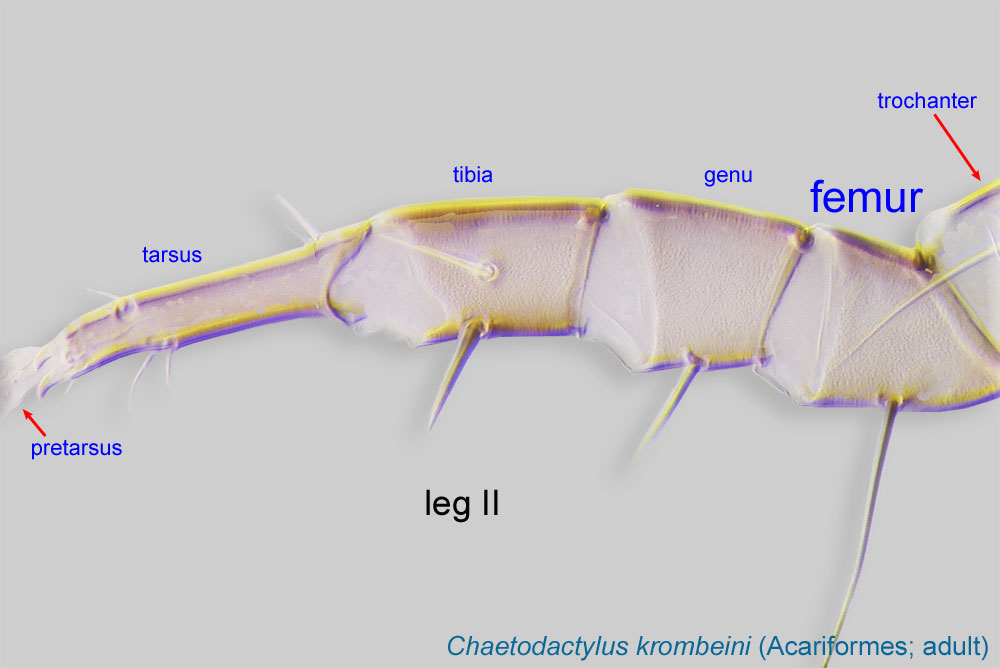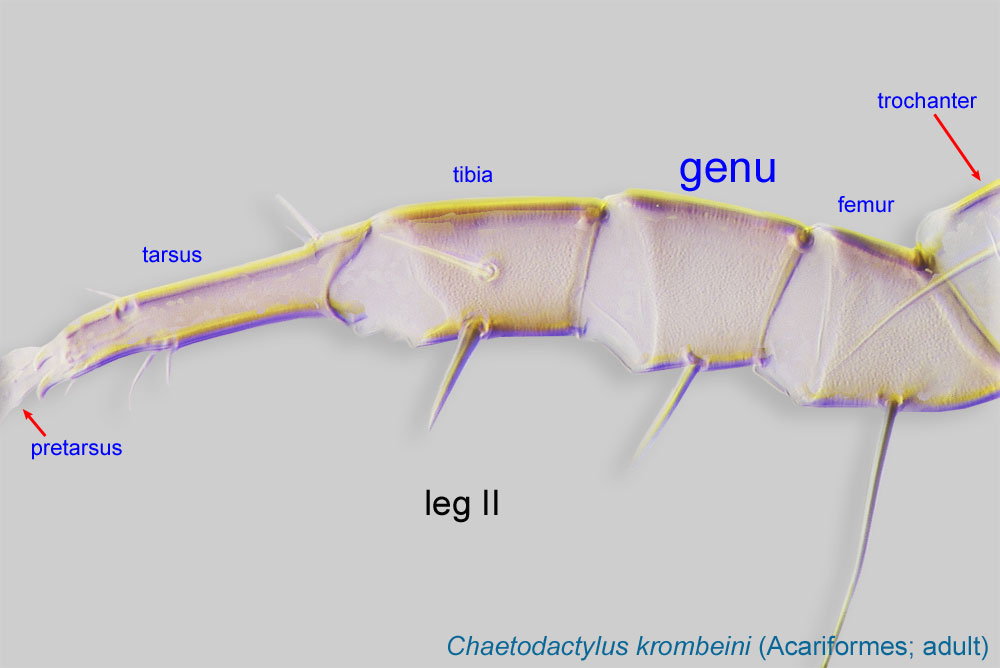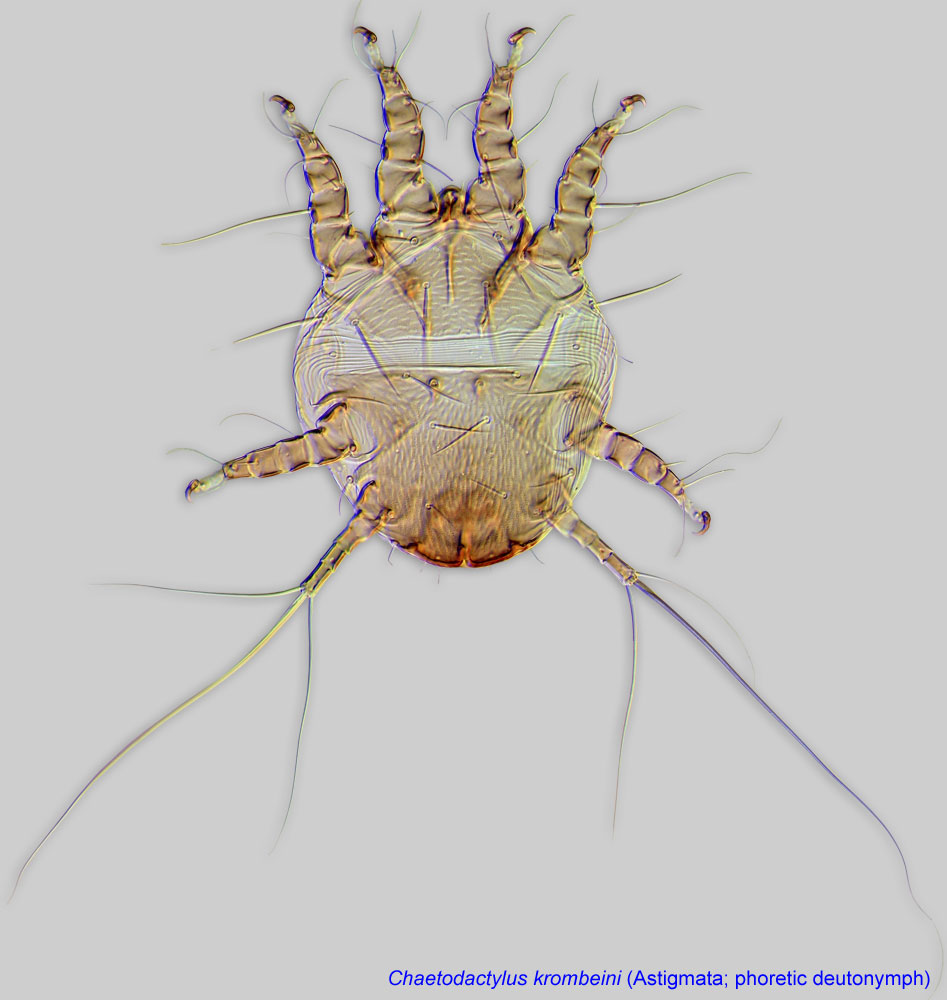neutral to potentially beneficial; feed primarily on fungi
Scutacarus Gros, 1845
Superorder Acariformes » Order Trombidiformes » Suborder Prostigmata » Infraorder Eleutherengona » Hyporder Heterostigmata » Family Scutacaridae » Genus Scutacarus
Acarus acarorum Goeze, 1780
Female: Setae c1 in central part of tergite C (not on its free, striated margin) (Fig. 1). Legs IV 4-segmented (trochanter, femurfemur:
Leg or palp segment (also known as podomere or palpomere) between genu and trochanter. In ParasitIformes can be subdivided into telofemur and basifemur.
 , genugenu:
, genugenu:
Leg or palp segment (also known as podomere or palpomere) between tibia and femur.
 , and tibiotarsus) (Fig. 6). Tibiotarsus IV with more than 4 setae (Fig. 6).
, and tibiotarsus) (Fig. 6). Tibiotarsus IV with more than 4 setae (Fig. 6).
This is a species-rich genus, containing both bee-associated and non bee-associated mites. Except for a key to Palaearctic species (Khaustov, 2008Khaustov, 2008:
Khaustov, A. A. 2008. Mites of the family Scutacaridae of Eastern Palaearctic. Kiev: Akademperiodika. 290 pp.), no other keys are available. There are five species associated with bees. Four species associated with bumble bees (Scutacarus acarorum, S. deserticolus, S. mendax, and S. occultatus) can be identified using Jagersbacher-Baumann, 2014Jagersbacher-Baumann, 2014:
Jagersbacher-Baumann, J. 2014. Species differentiation of scutacarid mites (Heterostigmatina) using multivariate morphometric methods. Experimental and Applied Acarology 62: 279-292. and Khaustov, 2008Khaustov, 2008:
Khaustov, A. A. 2008. Mites of the family Scutacaridae of Eastern Palaearctic. Kiev: Akademperiodika. 290 pp.. The remaining species, Scutacarus eickworti, from halictid bees in the USA, can be identified using Delfinado and Baker, 1978Delfinado and Baker, 1978:
Delfinado, M. D. amp; E. W. Baker. 1978. Terrestrial mites of New York - 7. Key to the species of Scutacaridae and descriptions of new species. Journal of the New York Entomological Society 86: 87-101..
Cosmopolitan. Species associated with bees have been found in the Holarctic region.
commonly found on bumble bees (Bombus) (Fig. 7) and accidentally on the European honey bee, Apis mellifera (as a result of transfer from bumble bees); one species found on Lasioglossum (Dialictus).
Species found on bees display a tendency toward permanentpermanent:
associated exclusively with bees or their close relative, wasps; cannot live without these hosts
associations: they normally live in bee nests but can also live in other habitats.
Most species of this genus are free-living in litter and moss. Many species are associated with ants, living in their nests and using adult insects for dispersal. A few species have been found to be phoreticphoretic:
Pertaining to phoresy; using another organism (i.e., a host) for dispersal to new habitats. Phoresy can be distinguished from parasitism because feeding typically does not occur during phoresy.
on beetles and flies. The occurence of Scutacarus acarorum, normally associated with bumble bees, on the honey bee or in its nest is attributable to the fact that overwintered Bombus queens often enter honey bee hives (Schousboe, 1986Schousboe, 1986:
Schousboe, C. 1986. On the biology of Scutacarus acarorum Goeze (Acarina: Trombidiformes). Acarologia (Paris) 27: 151-158.). It is unknown whether S. acarorum can live sustainably in association with honey bees. Scutacarus acarorum has been found hyperphoretic on mite deutonymphsdeutonymph:
Ontogenetic stage between protonymph and tritonymph (or adult, if tritonymph is absent). See <a href="index.cfm?pageID=1720">Life stages page</a> for more details. of the genus Parasitellus (Parasitidae) that are in turn phoreticphoretic:
of the genus Parasitellus (Parasitidae) that are in turn phoreticphoretic:
Pertaining to phoresy; using another organism (i.e., a host) for dispersal to new habitats. Phoresy can be distinguished from parasitism because feeding typically does not occur during phoresy.
on their bumble bee hosts.